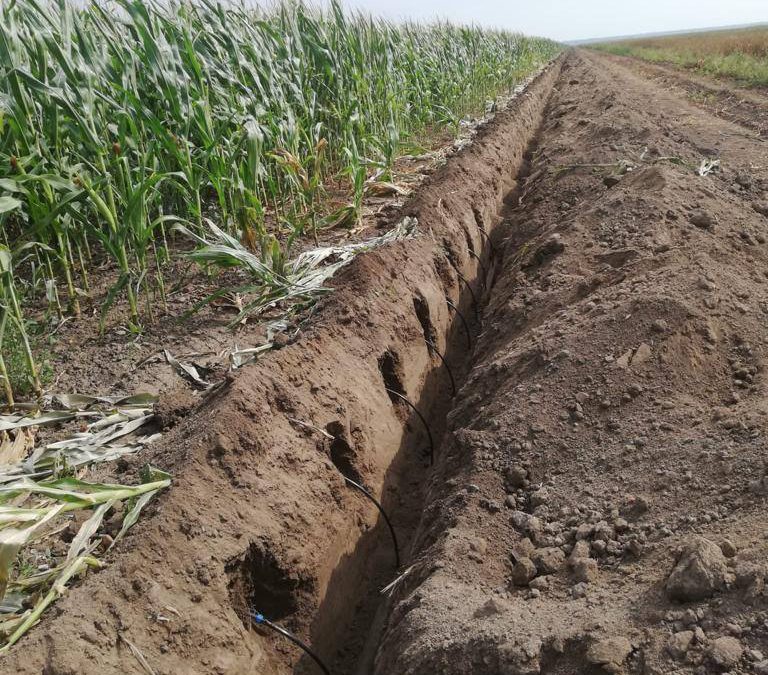Corn crops are irrigated by underground systems around the world. The results of this agrotechnical method bring an increase in yield while saving water, chemical protection agents, and fertilizers so that this type of irrigation has proven to be undoubtedly the most cost-effective way to successfully grow corn. Subsurface drip irrigation systems are most suitable for large field operations. Compared to surface systems, this system brings additional benefits such as lower labor requirements and no interference to other agricultural technology.
Subsurface drip irrigation is a system in which the dripper is permanently buried below the soil surface so that the water supply goes directly to the roots. It is more than an irrigation system, it is a real tool for root zone management.

In this way, the fertilizer can be applied to the root zone in a defined amount and at the right time when it will be most favorable – which will result in greater efficiency and better crop performance. Many crop protection chemicals are also available (labeled accordingly) for application through the drip system making it a powerful crop protection tool.
When choosing such systems, as well as during every investment, one should be guided by the relationship between quality and price, and an important factor for making such a decision is the reputation of the manufacturer.
AVITAL AGRO is the exclusive distributor of the Israeli company Netafim, which invented “drip irrigation systems” and which has been producing subsurface drip irrigation systems for more than 20 years. Our experts are familiar with the specifics of the area and the quality of the land and can provide enough information and advice to achieve maximum results with minimal investment and risk. Your dealer AVITAL AGRO is familiar with local conditions and will recommend a dropper that suits your area. It is best to install a dropper with GPS wherever it is possible so that its position can be determined at any time.
Depending on the local conditions, the dropper may have a pressure compensator, but there are also droppers without this compensator. Factors such as soil type, topography, and water quality will play an important role in choosing the right dropper.
Water use is designed to meet crop needs given the water availability. Depending on the crop being grown, the texture of the soil, and the presence of rodents, the depth at which the dropper is placed is also determined. If the soil is sandy, the drip is placed shallower, and if it is in areas with a larger population of rodents, the drip will be placed deeper, to reduce the probability of damage. However, placing a dropper at depths that are not ideal can make germination difficult, so many factors are considered in the calculations.
The volume output of the pumping station dictates the amount of area that can be irrigated.
The filter system protects the drip system from sand and other small particles that can clog the system’s drippers. A well-designed filter system maximizes the performance and longevity of your system. Care should also be taken to properly design pressure control valves, ventilation ducts, fertilizer injection systems, and flow to monitor system operation.
To achieve the highest possible yields and water savings with a drip irrigation system, it is necessary to monitor your system and make adjustments. Besides, regular monitoring of the system can alert to potential problems.

Growers who are considering switching to an underground drip irrigation system have many benefits that they can count on.
AGRONOMIC BENEFITS:
- Superior watering and nutrition drip is a precise water/nutrient delivery system that irrigates the plant’s root zone, not the soil
- High flexibility and versatility: drip adapts to almost any field size, shape, or topography
- Superior watering and nutrition drip is a precise water/nutrient delivery system that irrigates the plant’s root zone, not the soil
- High flexibility and versatility: drip adapts to almost any field size, shape, or topography
- Superior watering and nutrition drip is a precise water/nutrient delivery system that irrigates the plant’s root zone, not the soil
- High flexibility and versatility: drip adapts to almost any field size, shape, or topography
- Superior watering and nutrition drip is a precise water/nutrient delivery system that irrigates the plant’s root zone, not the soil
- High flexibility and versatility: drip adapts to almost any field size, shape, or topography
- Superior watering and nutrition drip is a precise water/nutrient delivery system that irrigates the plant’s root zone, not the soil
- High flexibility and versatility: drip adapts to almost any field size, shape, or topography
ECONOMIC BENEFITS:
- High, quality yields: drip is a precise delivery system, leading to greater growth consistency, crop quality, and yields
- Low water usage: drip enables decreased evaporation, run-off, and uneven distribution that reduces water usage by up to 50%
- Low energy usage: drip operates at low pressure, making it the lowest consumer of energy among pressurized systems
- Low input costs: drip efficiently applies water and nutrients that reduce input costs
- Long-lasting performance
- Dripper lines for on-surface and subsurface drip systems can last for up to 5 and 20 years, respectively

